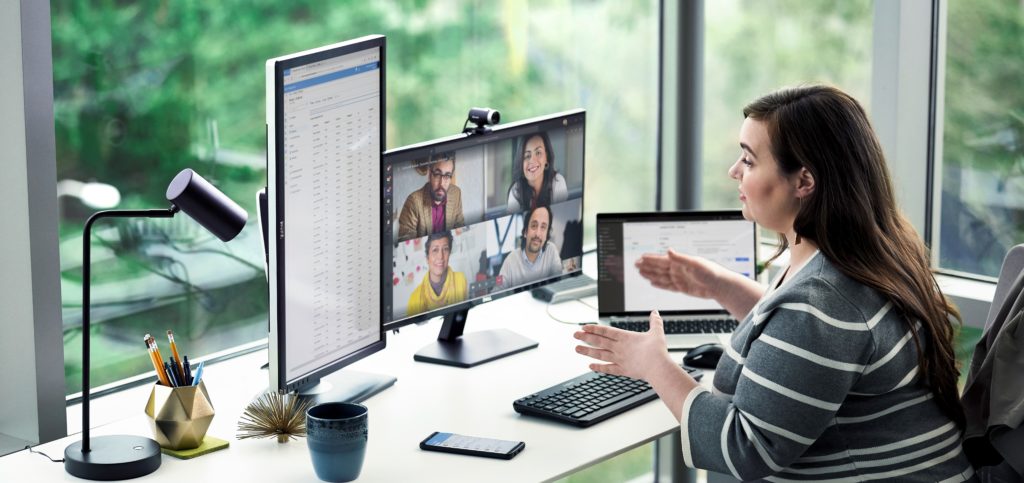
April 7, 2020
In China, managing relationships, teams, and more meetings from home
Editor’s Note: COVID-19 has impacted people around the world, challenging us to adapt to travel restrictions, school closures, and the removal of barriers between work and life—all at once. So, what does a cross-functional team of engineers, data scientists, analysts, and marketers that lives in the space between workplace culture and data do when presented with the world’s largest work-from-home shift? It, well, does its homework. In this blog series, we’ll share real-time learnings as we measure the impact of this unprecedented shift on how one group of employees works, connects, and balances our lives. We hope these insights will teach us something about how work is changing and help us all get through this, together.
For much of the world’s population, the past few weeks have been defined by a series of dramatic changes to daily life, from school and office closures to increased anxiety and health concerns. But for our colleagues in China, these changes hit back in January.
To start to understand how this shifting landscape could impact work in other parts of the world, we looked back to see what data could teach us from China. We set out with a wide-angle lens focused on workplace collaboration, looking to uncover patterns, stories that surprised us, and a sense of what this change felt like to employees.
A few key findings—about how people maintained communities, managed people remotely, and responded to the potential menace of multitasking—jumped out at us.
Not only can these lessons potentially help our partners, our customers, and our own teams across Microsoft navigate the current move to remote work during this crisis, but we think they will also help us all transition back to a new normal when that time comes.
Maintaining community amid disruption
While nearly all Microsoft China employees were working from home, and with business and home life anything but usual, we expected to see a dramatic shrinking of networks—the existing circle of relationships people connect with in the course of their work. The reality was different.
After shifting to remote work, a quarter of employees experienced no significant change in their networks (i.e., their networks were within 10 percent of their original size). Two-thirds of employees maintained networks that were within 30 percent of their original size.

Finding: Many employee networks stayed the same size. And most that did change significantly got bigger, not smaller.
But something else surprised us. Of the third of employees whose networks did change significantly, not all experienced network shrink—the way we might have assumed as people navigated new work environments and schedules and lost the face-to-face connections they were used to. In fact, more than half saw their networks grow larger. In other words, one out of every six employees had networks that were 30 percent larger than the before.
Maintaining strong networks is important because social isolation can take a hidden, costly toll on people’s wellbeing. And from a business perspective, decreases in network size indicate reductions in cross-team and intra-organizational collaboration, which can lead to reduced innovation, longer times to market, decreased employee engagement over time, etc.
Daily planning, regular 1:1s with team members, review meetings, customer and partners calls, and making sure to spend time with family—these all helped us stay connected and supported.Sales Director, Microsoft China
The data showing network growth among employees in China is not only surprising, it’s encouraging. It suggests that a shift to remote work does not inherently mean that people’s networks will suffer; in fact it suggests that strong, flexible networks are key to navigating big change.
We were also concerned that the loss of face-to-face interactions could lead to loneliness or disengagement. While we don’t have data to support how people felt, we have many anecdotes from people who turned to technology to ease that loss. Refreshingly, those anecdotes aren’t simply meetings that were once around a conference table and now on video conference. Instead, we’re overwhelmed with stories of technology bringing more of the human to work—from employees proudly showing off babies during calls to countless pet cameos.
Managing people remotely
Another fascinating story, based on the scale of the impact alone, was how much one cohort in particular was affected by the shift to 100 percent remote work: people managers (i.e. managers of individual contributors). Managing people remotely while juggling individual projects is a common challenge voiced by people in this role. In times of change and uncertainty, these challenges appear to be magnified.
Finding: While managers worked remotely, their IMs and voice and video calls surged.
Managing people and teams remotely, managers in China relied heavily on instant messages, which increased 65 percent among managers, and Microsoft Teams voice and video calls, which doubled from 7 to 14 hours per week.
At the same time, the data showed that email volumes remained constant, suggesting that our workforce prefers instant messages and Teams calls to replace face-to-face conversation.
One best practice is to stay connected. Weekly team meetings and 1:1s helped a great deal in building the bond among my team even while remote.Director, Microsoft China
The side-by-side heatmaps (below) highlight the additional collaboration noted above, with most of the increase happening in the afternoons. The increased meeting load undoubtedly contributes to the feeling of extended working hours that we heard about anecdotally, especially as video calls keep employees rooted in front of their computer without the normal walk between meeting rooms in the office.

Finding: People managers in China spent 90 minutes more each week engaged in work, and had more calls and meetings during the daytime.
It’s clear that while managing people remotely, employees in China were spending more hours interacting throughout the workday. What’s also clear is that they were engaged with work for a larger span of each working day. In fact, when you aggregate over a week, people managers in China were engaged with work an extra 90 minutes each week. This would mean an extra 22 minutes each day Monday – Thursday, assuming they still paused work at their usual time for the weekend. The data suggests that much of the increased afterhours work is individual work (i.e. not calls, meetings, etc.).
The patterns we see here—more collaboration during business hours, less after business hours, but longer days overall—is one that matches the behavior of shutting down work at the end of the ”normal” workday, spending time with family, then logging back in before bed. We believe we’re observing employees’ efforts to keep work and life separate when the physical boundaries disappeared, which is supported by stories our colleagues shared.
Staying focused in meetings
The last story that jumped out at us was actually a story that didn’t come to pass. With everyone working from home, we had every reason to expect multitasking in meetings to increase. There was no longer the social pressure of a colleague sitting across the table. People were in more meetings, meaning they had less time outside meetings to email. Working from home naturally increases the number of distractions, each of which is a cue to disengage.
Finding: While meeting remotely, employees were equally as focused as they were before the shift.
But, surprisingly, employees remained just as focused working remotely as they were in the office, with 90 percent of employees multitasking in email during fewer than 10 percent of their meetings.
The change to working from home, while simultaneously juggling added responsibilities, emotions, and concerns, has challenged organizations all over the world, including Microsoft. The data and our colleagues in China, who began working remotely a month or more earlier than the rest of us, provide lessons and insights on how to navigate the transition when works shifts dramatically. Although there are challenges, especially for our managers, we are confident that we can adapt so that we can continue developing the tools and products that empower every person and organization on the planet to achieve more.
Methodology: To help us chronicle the journey of our 300-person organization, we draw on data from Workplace Analytics to help quantify the impact on collaboration, networks and focus, explore the lived experiences of our teammates through surveys and interviews, and tap into the knowledge of experts where it helps our understanding.
Research Lead: Kevin Sherman
Series Editor: Natalie Singer-Velush





